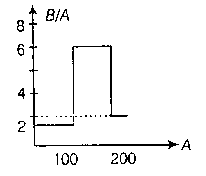Photoelectric effect experiments are performed using three different metal plates \(p,q\) and \(r\) having work functions \(Q_{p}=2\)e V , \(Q_{q}=2.5\)eV and \(Q_{r}=3.0\)e V , respectively. A light beam containing wavelength of \(550\) nm, \(450\) nm and \(350\) nm with equal intensities illuminates each of the plates. The correct \((I\text-V)\) graph for the experiments is: (Take \(\text{hc}=1240~\text{eV-nm}\))
1.

2.

3.

4.

| 1. |  |
2. |  |
| 3. |  |
4. |  |
Three long wires, each carrying current i are placed parallel to each other. The distance between I and II is 3d, between II and III is 4 d and between III and I is 5d. Magnetic field at side of wire II is
1.
2.
3.
4.
In the following diagrams, a particle with small charge – q is free to move up or down, but not sideways near a larger fixed charge Q. The small charge is in equilibrium because in the positions shown, the electrical upward force is equal to the weight of the particle. Which statement is true?
1. In figure a, -q is in stable equilibrium.
2. In figure a, -q is in neutral equilibrium.
3. In figure b, -q is in stable equilibrium.
4. Neither in fig(a) nor in fig(b) , q is in stable equilibrium.
\(1. \frac{1}{24} m A\\ 2. \frac{1}{12} m A\\ 3. \frac{1}{6} m A\\ 4. \frac{1}{3} m A\)
Assume that the nuclear binding energy per nuclear (B/A) versus mass number (A) is as shown in the figure. Use this plot to choose the correct choice(s) given below:
1. Fusion of two nuclei with mass number lying in the range of 51<A<100 will release energy
2. Fusion of a nucleus lying in the mass range of 200<A<260 will release energy when broken into two equal fragments
3. Both A and B
4. None of these










